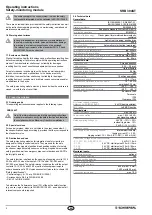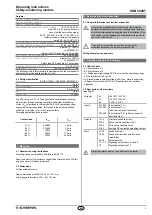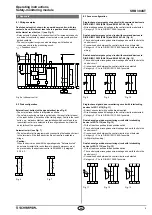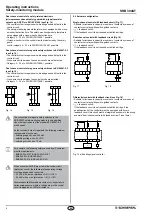
6
Operating instructions
Safety-monitoring module
SRB 304ST
EN
Dual-channel control of a safety-related electronic
(microprocessor-based) safety guard with p-type transistor
outputs e.g. AOPD's to EN IEC 61496 (see Fig. 14)
• The control system recognises wire-breakage and earth faults in the
control circuit.
• The safety-monitoring module therefore is not equipped with a cross-
wire short detection here. The safety-monitoring module therefore is
not equipped with a cross-wire short detection here.
• Category 3 – PL e to DIN EN ISO 13849-1 possible.
• If cross-wire shorts in the control circuits are detected by the safety
guard:
control category 4 – PL e to DIN EN ISO 13 849-1 possible.
Dual-channel control of magnetic safety switches to EN 60947-5-3
(see Fig. 15)
• The control system recognises wire-breakage and earth faults in the
control circuit.
• Cross-wire shorts between the control circuits are not detected.
• Category 3 – PL e to DIN EN ISO 13849-1 possible.
Dual-channel control of magnetic safety switches to EN 60947-5-3
(see Fig. 16)
• The control system recognises wire-breakage and earth faults in the
control circuit.
• Cross-wire shorts between the control circuits are detected.
• Category 3 – PL e to DIN EN ISO 13849-1 possible.
S12
+24V
S32
+24V
S22
S21
S32
S31
S12
S11
S22
S21
S22
S21
S12
S11
S32
S31
Fig. 14
Fig. 15
Fig. 16
The connection of magnetic safety switches to the
SRB 304ST safety-monitoring module is only admitted
when the requirements of the standard EN 60 947-5-3
are observed.
As the technical data are regarded, the following minimum
requirements must be met:
– switching capacity: min. 240 mW
– switching voltage: min. 24 VDC
– switching current: min. 10 mA
For example, the following safety sensors from Schmersal
meet the requirements:
– BNS 33-02z-2187, BNS 33-02zG-2187
– BNS 260-02z, BNS 260-02zG
– BNS 260-02-01z, BNS 260-02-01zG
When sensors with LED are wired in the control circuit
(protective circuit), the following rated operating voltage
must be observed and respected:
– 24 VDC with a max. tolerance of –5 %/+ +20 %
– 24 VAC with a max. tolerance of –5 %/+ +10 %
Otherwise availability problems could occur, especially in
series-wired sensors, where a voltage drop in the control
circuit is triggered by LED's for instance.
8.4 Actuator configuration
Single-channel control with feedback circuit (Fig. 17)
• Suitable for increase in capacity or number of contacts by means of
contactors or relays with positive-guided contacts.
•
S
= feedback circuit:
If the feedback circuit is not required, establish a bridge.
Dual-channel control with feedback circuit (Fig. 18)
• Suitable for increase in capacity or number of contacts by means of
contactors or relays with positive-guided contacts.
•
S
= feedback circuit:
If the feedback circuit is not required, establish a bridge.
X1
X2 13
14
K
A
S
L1
N
K
A
X1
X2 13
14
K
B
K
A
K
B
L1
N
K
A
S
Fig. 17
Fig. 18
Differential control with feedback circuit (see Fig. 19)
• Suitable for increase in capacity or number of contacts by means of
contactors or relays with positive-guided contacts.
•
S
= feedback circuit:
If the feedback circuit is not required, establish a bridge. If the
enabling circuit of the controller must be equipped with its own
feedback circuit, this circuit must be integrated as shown in the wiring
example "dual-channel control with feedback circuit" (see there).
X1
X2
23
13
24
14
K
A
L1
N
K
A
S
a)
Fig. 19 a) Enabling signal controller


























